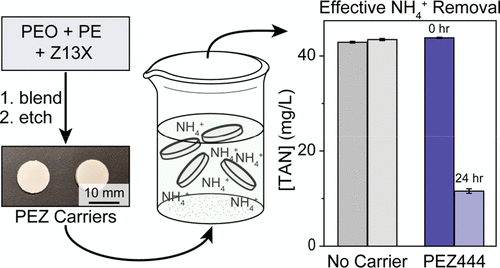当前位置:
X-MOL 学术
›
ACS ES&T Eng.
›
论文详情
Our official English website, www.x-mol.net, welcomes your
feedback! (Note: you will need to create a separate account there.)
Porous Polyethylene-Supported Zeolite Carriers for Improved Wastewater Deammonification
ACS ES&T Engineering ( IF 7.4 ) Pub Date : 2021-05-07 , DOI: 10.1021/acsestengg.1c00077 Elizabeth C. Feinberg 1 , Anndee L. Huff Chester 2 , Paige J. Novak 2 , Marc A. Hillmyer 1
ACS ES&T Engineering ( IF 7.4 ) Pub Date : 2021-05-07 , DOI: 10.1021/acsestengg.1c00077 Elizabeth C. Feinberg 1 , Anndee L. Huff Chester 2 , Paige J. Novak 2 , Marc A. Hillmyer 1
Affiliation

|
Wastewater treatment is increasingly important as anthropogenic activities continue to stress our water systems. Ammonium is one of the most common pollutants in wastewater streams and is typically oxidized to nitrate during treatment, which still results in the discharge of reactive nitrogen to the environment. Anaerobic ammonium oxidation (anammox) can completely remove reactive nitrogen, forming dinitrogen, and also decreases the cost of ammonium removal compared to conventional activated sludge wastewater treatment systems. Anammox faces challenges in mainstream implementation, however, as a result of the slow growth rates of anammox bacteria, narrow ideal growth conditions, and competition with other taxa. Addition of zeolite, such as faujasite, into low ammonium waste streams improves ammonium removal and locally concentrates ammonium ions, which in turn can improve the proliferation of anammox bacteria. Here, we report the development of a scalable approach to plastic carriers for potential use in mainstream anammox reactors that combines the processability of thermoplastics and the ammonium sequestration ability of zeolites. Carriers were prepared by melt-blending polyethylene (PE), microparticulate zeolite 13X (Z13X, a faujasite), and a sacrificial poly(ethylene oxide) (PEO) template. Removal of the PEO template by solvent etching in water exposed a percolating pore network within the PE support structure and the particulate zeolite trapped within the exterior. A pore size in the range of 10–25 μm was typical, with zeolite loadings as high as 45% by mass in the final product. The hybrid inorganic–polymer carriers were highly effective in sequestering ammonium, capable of removing >75% of ammonium from a 45 mg/L TAN (total ammonium nitrogen) aqueous environment in 24 h at less than 1% mass loading of carriers as compared to solution mass. Ammonium removal by ion exchange was confirmed by spectrophotometric methods and by energy-dispersive X-ray spectroscopy, and the kinetics of ammonium sequestration were determined to be zeroth-order with respect to ammonium and first-order with respect to zeolite. The materials described in this article are expected to find utility in future bioreactor development.
中文翻译:

用于改进废水脱氨的多孔聚乙烯负载沸石载体
随着人为活动继续给我们的水系统带来压力,废水处理变得越来越重要。铵是废水流中最常见的污染物之一,通常在处理过程中被氧化成硝酸盐,这仍会导致活性氮排放到环境中。厌氧氨氧化(anammox)可以完全去除活性氮,形成双氮,与传统活性污泥废水处理系统相比,还降低了除氨成本。然而,由于厌氧氨氧化细菌生长速度缓慢、理想生长条件狭窄以及与其他分类群的竞争,厌氧氨氧化在主流实施中面临挑战。将沸石(例如八面沸石)添加到低铵废物流中可改善铵去除并局部浓缩铵离子,反过来又可以促进厌氧氨氧化菌的增殖。在这里,我们报告了一种可扩展的塑料载体方法的开发,可用于主流厌氧氨氧化反应器,该方法结合了热塑性塑料的可加工性和沸石的铵封存能力。通过熔融共混聚乙烯 (PE)、微粒沸石 13X(Z13X,八面沸石)和牺牲性聚(环氧乙烷)(PEO)模板制备载体。通过在水中的溶剂蚀刻去除 PEO 模板,暴露了 PE 支撑结构内的渗透孔网络和被困在外部的颗粒沸石。孔径在 10-25 μm 范围内是典型的,最终产品中沸石的含量高达 45%。杂化无机-聚合物载体在螯合铵方面非常有效,能够在 24 小时内从 45 mg/L TAN(总铵氮)水性环境中去除 >75% 的铵,与溶液质量相比,载体质量负载低于 1%。通过分光光度法和能量色散 X 射线光谱法证实了通过离子交换去除铵,并且确定铵螯合的动力学是关于铵的零级和关于沸石的一级。本文中描述的材料有望在未来的生物反应器开发中发挥作用。并且铵封存的动力学被确定为关于铵的零级和关于沸石的一级。本文中描述的材料有望在未来的生物反应器开发中发挥作用。并且铵封存的动力学被确定为关于铵的零级和关于沸石的一级。本文中描述的材料有望在未来的生物反应器开发中发挥作用。
更新日期:2021-07-09
中文翻译:

用于改进废水脱氨的多孔聚乙烯负载沸石载体
随着人为活动继续给我们的水系统带来压力,废水处理变得越来越重要。铵是废水流中最常见的污染物之一,通常在处理过程中被氧化成硝酸盐,这仍会导致活性氮排放到环境中。厌氧氨氧化(anammox)可以完全去除活性氮,形成双氮,与传统活性污泥废水处理系统相比,还降低了除氨成本。然而,由于厌氧氨氧化细菌生长速度缓慢、理想生长条件狭窄以及与其他分类群的竞争,厌氧氨氧化在主流实施中面临挑战。将沸石(例如八面沸石)添加到低铵废物流中可改善铵去除并局部浓缩铵离子,反过来又可以促进厌氧氨氧化菌的增殖。在这里,我们报告了一种可扩展的塑料载体方法的开发,可用于主流厌氧氨氧化反应器,该方法结合了热塑性塑料的可加工性和沸石的铵封存能力。通过熔融共混聚乙烯 (PE)、微粒沸石 13X(Z13X,八面沸石)和牺牲性聚(环氧乙烷)(PEO)模板制备载体。通过在水中的溶剂蚀刻去除 PEO 模板,暴露了 PE 支撑结构内的渗透孔网络和被困在外部的颗粒沸石。孔径在 10-25 μm 范围内是典型的,最终产品中沸石的含量高达 45%。杂化无机-聚合物载体在螯合铵方面非常有效,能够在 24 小时内从 45 mg/L TAN(总铵氮)水性环境中去除 >75% 的铵,与溶液质量相比,载体质量负载低于 1%。通过分光光度法和能量色散 X 射线光谱法证实了通过离子交换去除铵,并且确定铵螯合的动力学是关于铵的零级和关于沸石的一级。本文中描述的材料有望在未来的生物反应器开发中发挥作用。并且铵封存的动力学被确定为关于铵的零级和关于沸石的一级。本文中描述的材料有望在未来的生物反应器开发中发挥作用。并且铵封存的动力学被确定为关于铵的零级和关于沸石的一级。本文中描述的材料有望在未来的生物反应器开发中发挥作用。











































 京公网安备 11010802027423号
京公网安备 11010802027423号